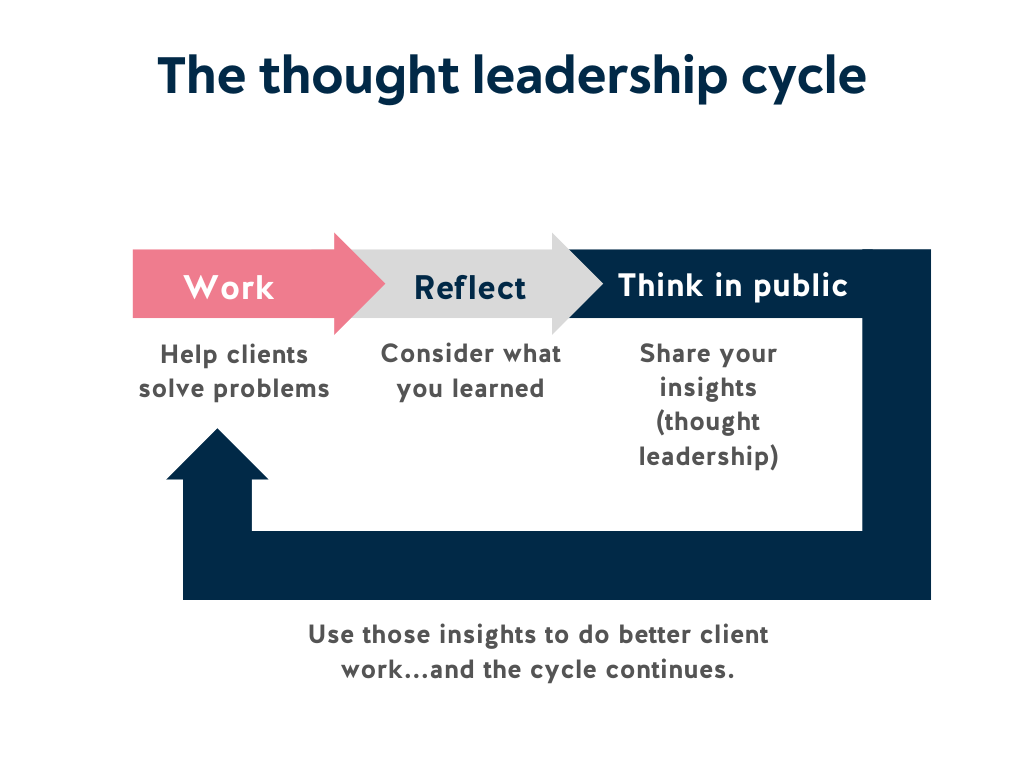Are you a thought leader?
Yes, you. (Hi! 👋)
If you’re thinking, “No way” or “Who me?” this is for you.
If you’re doing good work, it’s not a huge leap to start reflecting on that work and sharing your insights. Thought leadership is helpful for your own learning — and a generous act that helps others.
I’m giving you this pep talk because I’ve been preparing a workshop for a group of aspiring thought leaders. My goal: Show them how to start thinking in public about their work, little by little, on a regular routine, and build a sustainable thought leadership *practice*.
Most people, including people who are very good at their jobs, don’t think in public. They’re too busy doing the work. Head down, making an impact, getting it done. So creating a new routine of talking about that work can feel very uncomfortable.
But thought leadership (thinking in public) isn’t about bragging or grandstanding. It’s actually about the very humble art of reflection and the generous gift of sharing that reflection.
Thought leaders aren’t the loudest voices in the room. They aren’t the people with the most controversial opinions. Thought leaders are people who have ideas and perspectives, and who take the time to reflect and share that perspective.
Thinking like a thought leader is a mindset shift — instead of “do good work, repeat, repeat, repeat,” it’s “do good work, reflect, think in public, and use those reflections to improve your work…repeat, repeat, repeat.”
That thought leadership cycle looks like this:
Since you’re already doing Step 1 (do good work), let’s zoom in on Steps 2 and 3: Reflect and Think in Public.
Reflect
How could you start reflecting on your work? How could you build reflection into your weekly routine? Try these micro-changes to start reflecting.
- Think back. On Friday mornings, spend 20 minutes reflecting on the week. Note the progress you’ve made. Write down the biggest challenges you’ve faced. Ask questions about how you could approach next week differently.
- Partner up. Do you have a colleague or friend who could take on this project with you? You could be each other’s accountability partner. Once a week, take a walk together or schedule a Zoom to talk through what’s happening in your work. Their questions will help you crystallize what’s interesting, what’s working, and what you could explore further.
- Piggyback. Not sure how to start reflecting on your own experiences? That’s fine. You can start by learning from other people’s reflections. Seek out other people’s ideas. Listen to podcasts in your space. Read articles by people who are doing similar work. Explore what other people are talking about, and respond to it. What do you agree with? How do you think about your work differently? Use their reflections as a jumping-off place for your own thinking.
- Reminisce. The cool thing about starting a habit like this? You can look back and recount how you’ve thought about something in the past. Look back at your past work. What were you emailing about this time last year or the year before? What progress have you made since then? What have you learned? How do you approach your work differently now? That gap between where you’ve been and where you are now — and all the aha! moments along the way — is the perfect breeding ground for thought leadership.
Think in public
After you reflect on your work and consider what ideas you want to tackle, find a way to share those reflections.
Create your own “idea lab” where you can start to throw your ideas against the wall.
Sharing your ideas regularly might look like:
- Long-form: Starting a blog, a Substack, or an email newsletter where you write regularly.
- Social media: Posting your thoughts on LinkedIn every week.
- Internal: Writing an internal newsletter or Slack update to your team or department to sum up what’s happening and how you’re thinking about progress.
- Save for later: Keeping notes that you can turn into a presentation at your next big internal meeting.
In sum, you’re already doing good work. How could you make minor shifts to start reflecting on that work and sharing it more broadly? My suspicion: You (yes, you! 👋) are a thought leader, after all.








